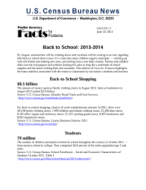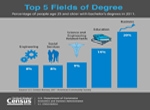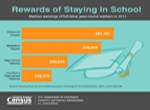Facts for Features: Back to School 2013-2014
By August, summertime will be winding down and vacations will be coming to an end, signaling that back-to-school time is near. It's a time that many children eagerly anticipate — catching up with old friends and making new ones, and settling into a new daily routine. Parents and children alike scan the newspapers and websites looking for sales to shop for a multitude of school supplies and the latest clothing fads and essentials. This edition of Facts for Features highlights the many statistics associated with the return to classrooms by our nation's students and teachers.
Back-to-School Shopping
$8.5 billion
The amount of money spent at family clothing stores in August 2012. Sales at bookstores in August 2012 totaled $2.0 billion.
Source: U.S. Census Bureau, Monthly Retail Trade and Food Services
<//www.census.gov/retail/index.html#mrts>
For back-to-school shopping, choices of retail establishments abound: In 2011, there were 28,128 family clothing stores, 7,093 children and infants clothing stores, 25,448 shoe stores, 8,144 office supply and stationery stores, 21,227 sporting goods stores, 8,407 bookstores and 8,625 department stores.
Source: U.S. Census Bureau, County Business Patterns: 2011
<//www.census.gov/econ/cbp>
Students
79 million
The number of children and adults enrolled in school throughout the country in October 2011 -- from nursery school to college. They comprised 26.9 percent of the entire population age 3 and older.
Source: U.S. Census Bureau, School Enrollment - Social and Economic Characteristics of Students: October 2011, Table 1
<//www.census.gov/hhes/school/data/cps/2011/tables.html>
Pre-K through 12 Enrollment
77%
Percentage of children 3 to 6 enrolled in kindergarten who attended all day, as of October 2011.
Source: U.S. Census Bureau, School Enrollment - Social and Economic Characteristics of Students: October 2011, Table 3
<//www.census.gov/hhes/school/data/cps/2011/tables.html>
73%
Percentage of children 3 to 6 years old who are enrolled in school.
Source: U.S. Census Bureau, School Enrollment - Social and Economic Characteristics of Students: October 2011, Table 3
<//www.census.gov/hhes/school/data/cps/2011/tables.html>
25%
Percentage of elementary through high school students who had at least one foreign-born parent in October 2011.
Source: U.S. Census Bureau, School Enrollment - Social and Economic Characteristics of Students: October 2011, Table 1
<//www.census.gov/hhes/school/data/cps/2011/tables.html>
Languages
11.8 million
Number of school-age children (5 to 17) who spoke a language other than English at home in 2011; 8.5 million of these children spoke Spanish at home.
Source: U.S. Census Bureau, 2011 American Community Survey
<//factfinder2.census.gov/bkmk/table/1.0/en/ACS/11_1YR/B16004>
Colleges
15%
Percentage of all college students 35 and older in October 2011. They made up 32 percent of those attending school part time.
Source: U.S. Census Bureau, School Enrollment - Social and Economic Characteristics of Students: October 2011, Table 5
<//www.census.gov/hhes/school/data/cps/2011/tables.html>
42%
Percentage of 18- to 24-year-olds enrolled in college in 2011.
Source: U.S. Census Bureau, School Enrollment - Social and Economic Characteristics of Students: October 2011, Table 1
<//www.census.gov/hhes/school/data/cps/2011/tables.html>
Work Status
52
Percentage of students enrolled in college, who worked less than full time, year-round in 2011; 20 percent worked full time, year-round.
Source: School Enrollment and Work Status: 2011 Appendix Table 1-A
<//census.gov/library/publications/2012/acs/acsbr11-14.html>
3,068,911
Number of enrolled high school students who work less than full time, year-round; 145,740 students in high school worked full time, year-round.
Source: School Enrollment and Work Status: 2011 Appendix Table 1A
<//census.gov/library/publications/2012/acs/acsbr11-14.html>
Field of Degree
12.0 million
Number of people age 25 and over who held a bachelor's degree in business in 2011. Business degrees were reported by 20 percent of the population with a bachelor's degree followed by education (14 percent), science and engineering related fields (9 percent), social sciences and engineering, which were not statistically different from each other (8 percent); biological, agricultural and environmental sciences (6 percent), and other and liberal arts and history, which were not statistically different from each other (5 percent); psychology (5 percent); literature and languages (4 percent); computers, mathematics and statistics (4 percent); visual and performing arts (4 percent); communications (4 percent); and physical and related sciences (3 percent).
Source: U.S. Census Bureau, 2011 American Community Survey
<//factfinder2.census.gov/bkmk/table/1.0/en/ACS/11_1YR/B15010>
Rewards of Staying in School
$81,761
Average earnings of full-time, year-round workers 18 and older with an advanced degree (bachelor's degree or higher) in 2011. Workers whose highest degree was a bachelor's had mean earnings of $70,459. Mean earnings for full-time, year-round workers with a high school diploma (includes GED certificate) was $40,634, while workers with less than a ninth grade education had $26,545 average earnings.
Source: Income, Poverty, and Health Insurance Coverage in the United States: 2011, Series P60-243
<//www.census.gov/hhes/www/cpstables/032012/perinc/pinc04_000.htm>
The following is a list of observances typically covered by the Census Bureau’s Facts for Features series:
| Black (African American) History Month (February) Super Bowl Valentine's Day (Feb. 14) Women's History Month (March) Irish-American Heritage Month (March)/ St. Patrick's Day (March 17) Earth Day (April 22) Asian/Pacific American Heritage Month (May) Older Americans Month (May) Mother's Day Hurricane Season Begins (June 1) Father's Day |
The Fourth of July (July 4) Anniversary of Americans With Disabilities Act (July 26) Back to School (August) Labor Day Grandparents Day Hispanic Heritage Month (Sept. 15-Oct. 15) Unmarried and Single Americans Week Halloween (Oct. 31) American Indian/Alaska Native Heritage Month (November) Veterans Day (Nov. 11) Thanksgiving Day The Holiday Season (December) |
Editor’s note: The preceding data were collected from a variety of sources and may be subject to sampling variability and other sources of error. Facts for Features are customarily released about two months before an observance in order to accommodate magazine production timelines. Questions or comments should be directed to the Census Bureau’s Public Information Office: telephone: 301-763-3030; or e-mail: [email protected].






